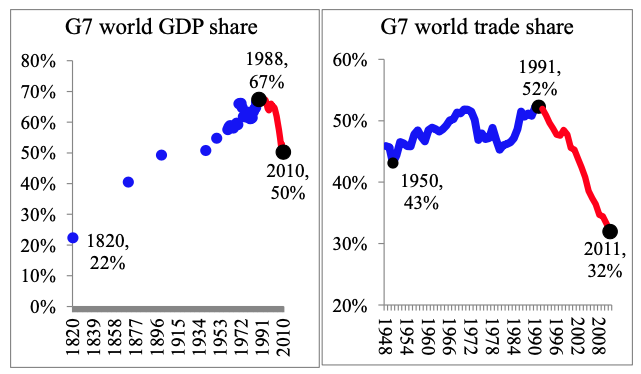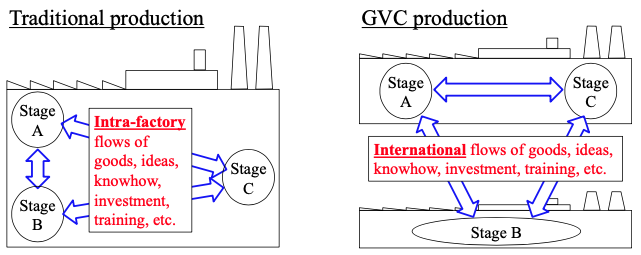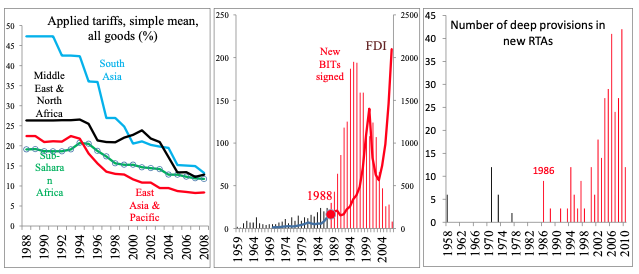We typically think about globalisation as a process driven by the gradual lowering of natural and man-made trade costs. This is a serious mistake. Modern globalisation is two processes, not one. I like to call them 'old' and 'new' globalisations (even though the old globalisation is still very much part of the present), or globalisation’s ‘first unbundling’ and ‘second unbundling’.
As we saw in my previous blog post, globalisation leaped forward in the late 19th century when steam power slashed the costs of moving goods internationally. Globalisation made a second leap in the late 20th century when ICT radically lowered the cost of moving ideasinternationally as well.
The two leaps had dramatically different effects (Figure 1).
Figure 1 Globalisation: One paradigm or two?
- The first leap (1820–1990). This might be called Old Globalisation, Phase 3, or the first unbundling. It created economic agglomeration in large industrialised nations. The G7 nations saw their share of world GDP soar from a fifth in 1820 to two-thirds in 1988. The share of world trade that the G7 commanded also rose steadily.
- The second leap (1990–present). We can call this New Globalisation, Phase 4, or the second unbundling. It sharply reversed the two-century-long trend in global shares. In just two decades the G7’s shares of world GDP and trade have plummeted to 50% and 32% respectively.
It started to reverse, if you will, the reversal of fortune that dominated the 18th and 19th centuries. This distinction, which I first wrote about in 2006 in a paper for the Finnish Prime Minister’s Office, and then developed at length in my 2016 book, requires some background.
Phase 4, or the second unbundling
The first unbundling created a paradox. Because distance didn’t die when transport costs fell, production dispersed internationally, but at the same time it clustered locally. Specifically, it clustered into factories and industrial districts. This paradox can be explained by the simple facts that cheap transport favoured large-scale production, such production tends to be very complex, and close proximity lowered the cost of coordinating complexity.
Think of a stylised factory with several production stages. Coordinating the whole process demands continuous, two-way flows of goods, ideas and people. Productivity-enhancing changes keep the process in flux, so the flows never stop. Stages are bundled together in a factory to save on the cost of coordination, not the cost of transportation. Two additional points: some of the coordination costs are actually communication costs, and different stages of production use skills and technology in very different proportions.
Figure 2 Global value chains turn intra-factory flows into international commerce
This new dictatorship of distance – one based on the high cost of communicating and coordinating geographically dispersed activities – was overthrown not by steam power, but by internet power. From the mid-1980s, telecom advances, strides in computing power, transmission capacities, and software created the ICT revolution. This new technology made it economical to geographically separate these manufacturing stages – in effect, to unbundle the factories. And once the unbundling of factories (the second unbundling) was feasible, vast international wage differences made it profitable. Some stages of production dispersed internationally. In this sense, the ICT revolution was to globalisation’s second unbundling what the steam revolution had been to globalisation’s first unbundling.
At an abstract level, lower trade costs relaxed the ‘transportation constraint’ that had bound together production and consumption spatially. Relaxing the transport constraint meant that the ‘coordination constraint’ became binding, and the result was vast agglomeration of manufacturing in a handful of countries. The ICT revolution relaxed the coordination constraint and the result was an unbundling of manufacturing facilities. The resulting internationalisation of production is also known as offshoring or the rise of global value chains.
This New Globalisation also fundamentally changed the nature of trade agreements that were necessary to allow globalisation to thrive. Many pro-jobs, pro-growth reforms require national action only. Some of the policies are designed to make international supply chains work better and make it easier to do business internationally. While some nations can get away with just changing their domestic laws, many developing nations found that their reforms were more convincing to G7 firms thinking about offshoring when they were baked into international agreements. The resulting trade agreements took the form of deep regional trade agreements (RTAs) and bilateral investment treaties (BITs).
Figure 3 The rise of 21st-century regionalism
The resulting set of disciplines is what I called ‘21st century regionalism’ in a 2011 paper. It involves North-South BITs and RTAs that included ‘deep provisions’, as well as developing-nation reforms such as unilateral tariff cuts (see Figure 3).
The New Globalisation was new in another way.
How second-unbundling globalisation is different
The New Globalisation impacts the economy with a finer resolution. The basic ‘finer resolution’ point can be illustrated with an example. During the Old Globalisation, international competition showed up in the form of a product – say, a Japanese automobile. The result was that international competition happened at the level of sectors, such as the auto sector. The US car industry was clobbered by Japanese competition in the 1980s, but the US wheat sector flourished. The fortunes of sectors tended to be shared with the productive factors used most intensively in the sectors, so labour skill-groups were also a useful aggregate for analytic purposes (not shown in diagram).
The New Globalisation allows international competitive pressures to operate at the level of stages of production within a sector – say, assembly of the bumpers, or wiring of the dashboard. The New Globalisation, in other words, reaches right into the factory to help or harm one particular production stage, or even one particular department or job.
The second unbundling’s impact is also more sudden. Reduced communication and coordination costs are difficult to control or slow down. Governments cannot choose to phase in ICT slowly, as they did with tariff cuts. Or more precisely, governments that try to slow down the impact of ICT risk losing even more jobs to nations that embrace it.
Finally, the second unbundling’s impact is also be more unpredictable. While most traded goods were affected proportionally by lower trade costs, it is difficult to predict which stages will become footloose as ICT progresses.
The problem is that economists and governments don’t really understand the ‘glue’ that makes it cheaper to bundle various stages of production into the same factor or office. We understand equally little about the connectivity of stages and occupations. And so the offshoring process is difficult to predict. Economic phenomena such as tipping points and threshold effects exaggerate the difficulties for forecasters (Baldwin and Venables 2013).
To summarise, as far as policy and institutions in rich nations are concerned, the main differences are that new-paradigm globalisation is individual, sudden and unpredictable.
Technology, not trade
The radical change in globalisation’s impact stems for the change in the things crossing borders. The New Globalisation, in short, is driven by cross-border movements of technology, not just more trade in goods. It is a trap to even think about the second unbundling as a trade phenomenon. But why did the knowhow start flowing from North to South?
When firms from high-technology nations offshore production stages, they naturally offshore managerial, technical and marketing know-how along with the jobs. This is because the off-shored stages have to mesh seamlessly and evolve in tandem with the rest of the production network. This combines one nation’s technology with another nation’s labour.
The firm-level motive is not – as was the case with the first unbundling – to exploit the nation’s comparative advantage by selling more goods abroad. The aim of a rich-nation firm is to make the most of its firm-specific know-how. It does this by combining it with low wages in developing nations. Trade and investment are just the by-products of this process.
Today's policymakers should not think of cross-border technology flows in the same way as the previous generation considered the cross-border flows of goods – at least when it involves offshoring to nations that have significantly worse technology. To illustrate this, consider an analogy. Allowing trade in goods is like allowing opposing football teams in different countries to exchange players – we can assume any voluntary exchange would make both teams better, and so it's in everyone's interest to encourage the trade.
Transferring technology, however, is like letting the better team train its opponents. The better team earns more money by doing it. A game between the two teams would surely be played at a higher level, but it is not clear that the interests of the better team and the national interest are the same.
New-paradigm thinking
Because globalisation’s impact is more individual, more sudden, and more unpredictable, wise governments should revise policies that were developed to deal with economic consequences of the first unbundling. It is much harder to identify the sunrise sectors in the New Globalisation. Therefore education, technology and industrial policy should be more nuanced, and nimbler.
- No jobs for life. One clear upshot of the New Globalisation is that fewer workers will have lifetime jobs, or spend a lifetime in one sector. This means that making it easier for individual workers to adjust to new tasks will become as important as giving basic education to children – ‘educate early and often’ should be the new motto for the educational establishment.
- Learning to learn. This may be as important as learning itself. Wise governments can reduce the pains from globalisation by teaching children that they will be engaged in life-long learning and providing the right institutions and incentives for continuing education and skill retraining.
- New labour market policies. Europe has two basic ‘flavours’ of labour market policies. Some nations (Denmark, for example) protect workers; others (including Spain) protect jobs. When globalisation affected economies in a gradual, predictable manner, this distinction was important – but not critical. The individuality, suddenness and unpredictability of new-paradigm globalisation make flexibility far more important. Firms that are locked into a view that particular workers do particular jobs will have an incentive to move much more of their production process abroad. For them, offshoring provides the ultimate labour market flexibility. Nations should shift toward protecting workers, not jobs.
Essential outcomes
Globalisation’s second unbundling has changed the world economy:
- The G7’s share of world GDP plummeted. A handful of developing nations soared. The dramatic changes were historic in size, but extremely concentrated geographically.
- The G7 deindustrialised. A handful of developing nations industrialised at a pace that is entirely without historical precedent. In just two decades, China’s world share of manufacturing leaped from under 5% to almost 20%.
- Income growth in the rapid industrialisers soared. This triggered a boom in commodity exports and prices known as the ‘commodity super-cycle’. This follow-on boom allowed a number of commodity-exporting nations – many of them developing nations – to join the growth bonanza of the rapid industrialisers.
- The nature of trade between the G7 and many developing nations changed dramatically. North-North trade had long been dominated by back-and-forth trade in parts and components. In the mid- to late-1980s, this spread to the trade between the G7 and rapidly industrialising developing nations.
- Trade has been set free. Almost all developing nations have massively liberalised their policies on trade, investment, capital, services and intellectual property.Industrial protectionism became industrial destructionism in the eyes of most developing nations. This was part of their effort to attract those offshored jobs and factories.
Concluding remarks
With these five blog posts I have traced out the long history of globalisation in brief – or well, not so brief. I hope to have made it clear that globalisation has changed radically in the past when big exogenous changes came along. Each time, it was wrong to continue using the mindset that helped understand the previous wave of globalisation. The same is true today.
In future blog posts – and in my forthcoming book, The Globotics Upheaval: Globalisation, Robotics and the Future of Work – I’ll peer into the crystal ball to see how digital technology (which really is as big a deal as ICT, and almost as big as steam power) will change globalisation.
References
Baldwin, R (2006), "Globalisation: The Great Unbundling(s)", Economic Council of Finland 20(3): 5-47.
Baldwin, R (2016), The Great Convergence: Information technology and the New Globalisation, Harvard University Press (Chapter 3).
Baldwin, R (2011), "21st Century Regionalism: Filling the gap between 21st century trade and 20th century trade rules", WTO Staff Working Paper ERSD-2011-08.
Baldwin, R and A J Venables (2011), "Spiders and snakes: Offshoring and agglomeration in the global economy", Journal of International Economics 90(2): 245-254




